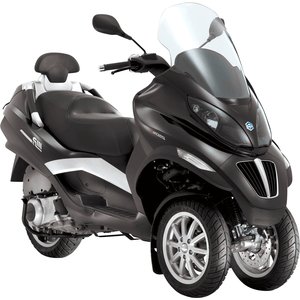Piaggio MP3 250 [2006-2010] Review: The Three-Wheeled Revolution That Redefined Urban Mobility
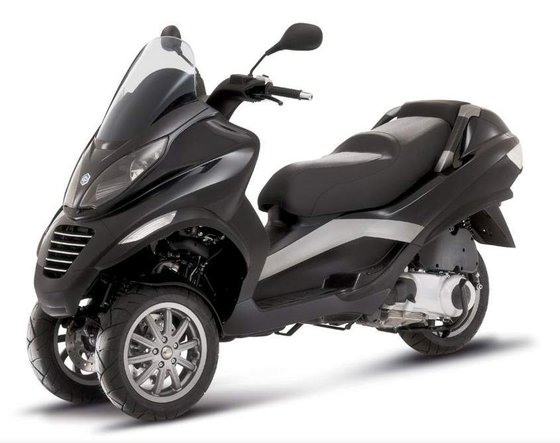
Introduction
The Piaggio MP3 250 isn’t just a scooter—it’s a statement. From 2006 to 2010, this audacious three-wheeler challenged conventions with its dual-front-wheel design, blending motorcycle agility with car-like stability. Whether you’re navigating rain-slicked cobblestones, dodging potholes, or carving through weekend backroads, the MP3 250 delivers a ride that’s equal parts practical and exhilarating. Having spent time with this generation, I can confirm: Piaggio didn’t just build a scooter here. They engineered a confidence-inspiring machine that makes even novice riders feel like seasoned urban adventurers.
Design & Ergonomics: Futuristic Form Meets Italian Flair

The MP3 250’s design screams innovation. That twin-front-end isn’t just a gimmick—it’s a meticulously engineered parallelogram suspension system housed in cast aluminum arms. From the side, the silhouette retains classic maxi-scooter proportions, but the front fascia looks like it rolled out of a sci-fi flick. The dual 12” front wheels (120/70 tires) sit proudly beneath angular bodywork that channels airflow away from the rider.
Practicality shines through details like the 65-liter under-seat storage—enough for two full-face helmets plus groceries—and a remote-controlled seat release. The 780mm (30.7") seat height welcomes shorter riders, while the integrated backrest and wide cushioning make all-day rides plausible. Piaggio’s wind tunnel work pays off: even at 110 km/h (68 mph), buffeting is minimal behind the stubby windshield.
Color options like Cortina Gray and Graphite Black age gracefully, though the plastics feel less premium than modern offerings. Still, the overall package balances futuristic swagger with real-world usability.
Performance: Small Engine, Big Personality
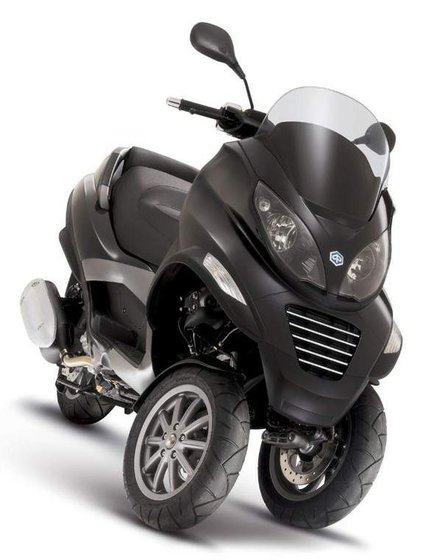
Don’t let the 244cc Quasar engine’s modest specs fool you. With 22.5 hp @ 8,250 rpm and 21 Nm (15.5 lb-ft) of torque, this liquid-cooled single thrives in urban chaos. The EFI system (a rarity in 2006 scooters) delivers crisp throttle response, launching from 0-50 km/h (0-31 mph) in 4.2 seconds—enough to gap traffic at lights. Top speed hovers around 120 km/h (75 mph), though sustained highway runs demand patience.
Where the MP3 truly astonishes is cornering. Leaning into a bend with 40° of tilt angle feels surreal initially—like the scooter’s defying physics—but the dual front tires dig in with tenacity. On damp roads where conventional bikes would squirm, the MP3 tracks like it’s on rails. Braking performance is equally mind-bending: twin 240mm front discs and a matching rear disc deliver 20% shorter stopping distances vs two-wheelers. Trail-braking into corners becomes a guilty pleasure.
Comfort & Daily Usability

Piaggio optimized the MP3 250 for city warfare. The electro-hydraulic tilt lock is a game-changer: hit the button below 24 km/h (15 mph), and the front suspension locks upright. No more awkwardly balancing at stoplights or searching for level parking spots. The mechanism disengages seamlessly as you accelerate—pure magic for commuters.
The 12L (3.2 gal) fuel tank grants ~250 km (155 mi) range, while the plush saddle and upright riding position prevent fatigue. Storage solutions impress: beyond the cavernous underseat compartment, there’s a locking glovebox and optional top case. My only gripe? The 215 kg (474 lb) wet weight complicates garage maneuvering, though the low CG helps once moving.
Technology: Ahead of Its Time
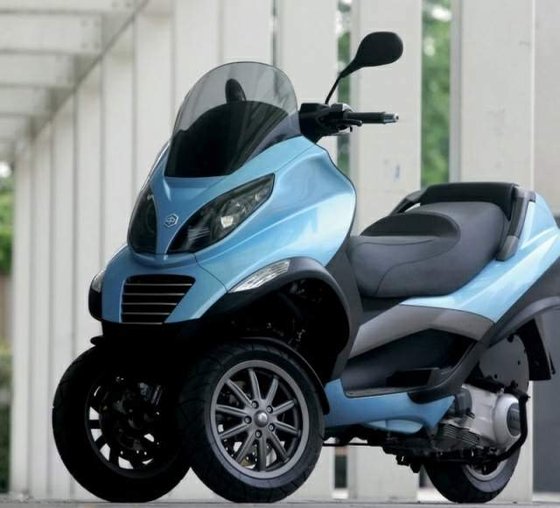
In 2006, the MP3’s tech suite felt space-age. The parallelogram front suspension remains its party trick—four aluminum arms allowing independent wheel movement while maintaining lean synchronization. Paired with adjustable rear shocks (preload only), it soaks up bumps better than many contemporary motorcycles.
The digital dash, while basic by today’s standards, provides essential data: speed, fuel level, twin trip meters, and a clock. An immobilizer system adds security, though the lack of modern connectivity feels dated. Still, optional extras like heated grips and a TomTom GPS (revolutionary in 2006!) showcased Piaggio’s forward thinking.
Competition: How Does It Stack Up?
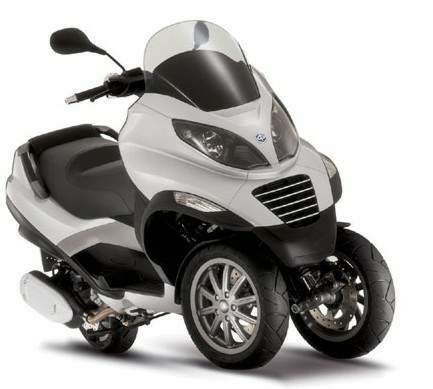
The MP3 250’s closest rivals were traditional maxi-scooters like the Yamaha TMAX 500 and Honda Silver Wing 600. While those offered more power (40-50 hp) and higher top speeds, they couldn’t match the Piaggio’s all-weather surefootedness. The MP3’s €1,000–2,000 price advantage also appealed to budget-conscious buyers.
Against peers like the Burgman 400, the Piaggio traded storage space for innovation. However, the MP3’s real competition was psychological—convincing riders that three wheels could be cool. Mission accomplished: its cult following persists, while many contemporaries faded into obscurity.
Maintenance: Keeping Your MP3 250 Thriving
Owning a 15-year-old MP3 requires vigilance. Here’s your MOTOPARTS.store cheat sheet:
- Engine Oil: Use SAE 5W-40 full synthetic (1.2L with filter). Change every 5,000 km (3,100 mi).
- Valve Adjustments: Check every 10,000 km (6,200 mi). Intake: 0.10mm (0.004"), exhaust: 0.15mm (0.006") (cold).
- Cooling System: Flush every 2 years with 2L of ethylene glycol mix. Watch for leaks near the water pump.
- Tires: OEM sizes (2x 120/70-12 front, 130/70-12 rear). Inflate to 1.6–1.8 bar (23–26 psi) front, 2.0–2.4 bar (29–35 psi) rear.
- Brakes: DOT 4 fluid changes biannually. Pad wear accelerates on heavier models—upgrade to sintered pads for aggressive riding.
Common issues include CVT belt wear (replace every 20,000 km/12,400 mi) and failing tilt-lock actuators. MOTOPARTS.store stocks OEM-spec belts, NGK PMR8B spark plugs, and upgraded Dr. Pulley sliders for smoother acceleration.
Conclusion: A Legacy of Innovation
The Piaggio MP3 250 wasn’t just a scooter—it was a mobility manifesto. For urban riders prioritizing safety without sacrificing fun, it remains peerless. While modern rivals offer more tech and power, none replicate the MP3’s grin-inducing duality: part motorcycle, part urban survival tool.
Whether you’re threading through gridlock or hunting twisty backroads, this Italian oddity proves three wheels > two. And with MOTOPARTS.store’s catalog, keeping your MP3 250 alive is easier than parallel parking a Smart car.
Ride safe, lean hard, and remember: stability never goes out of style.
Specifications sheet
| Engine | |
|---|---|
| Stroke: | Four-stroke |
| Max power: | 16 kW | 21.0 hp |
| Max torque: | 21 Nm |
| Fuel system: | EFI (Electronic Fuel Injection) |
| Max power @: | 8250 rpm |
| Displacement: | 244 ccm |
| Max torque @: | 6750 rpm |
| Configuration: | Single |
| Cooling system: | Liquid cooled |
| Compression ratio: | 10.5:1 (estimated based on Euro 3 compliance) |
| Number of cylinders: | 1 |
| Dimensions | |
|---|---|
| Wheelbase: | 1488 mm (58.6 in) |
| Dry weight: | 204 |
| Wet weight: | 215 |
| Seat height: | 780 mm (30.7 in) |
| Overall width: | 840 mm (33.1 in) |
| Overall height: | 1350 mm (53.1 in) |
| Overall length: | 2160 mm (85 in) |
| Storage capacity: | 65 L (17.2 US gal) |
| Fuel tank capacity: | 12 L (3.2 US gal) |
| Drivetrain | |
|---|---|
| Final drive: | Shaft |
| Transmission: | Automatic CVT (Twist-and-go) |
| Final drive oil capacity: | 250 ml SAE 80W-90 |
| Maintenance | |
|---|---|
| Idle RPM: | 1700 ± 100 rpm |
| Rear tire: | 130/70-12 |
| Engine oil: | 5W40 |
| Front tire: | 120/70-12 (x2) |
| Brake fluid: | DOT 4 |
| Spark plugs: | NGK PMR8B or Champion RG4PHP |
| Spark plug gap: | 0.7 |
| Coolant capacity: | 2.0 |
| Engine oil capacity: | 1.2 |
| Engine oil change interval: | Every 5000 km or annually |
| Valve clearance (intake, cold): | 0.10 mm |
| Valve clearance (exhaust, cold): | 0.15 mm |
| Recommended tire pressure (rear): | 2.4 bar (35 psi) |
| Recommended tire pressure (front): | 1.8 bar (26 psi) |
| Additional Features | |
|---|---|
| Security: | Electronic immobilizer |
| Parking brake: | Manual lever-operated system |
| Instrumentation: | Speedometer, fuel gauge, coolant temp, clock, odometer |
| Suspension locking system: | Electro-hydraulic tilt lock (activates below 15 mph) |
| Chassis and Suspension | |
|---|---|
| Frame: | High-tensile steel twin cradle |
| Tilt angle: | Up to 40° |
| Rear brakes: | Single 240 mm disc with 1-piston caliper |
| Front brakes: | 2 x 240 mm discs with 2-piston calipers |
| Rear suspension: | Twin hydraulic shock absorbers with 4-position preload adjustment |
| Front suspension: | Parallelogram system (4 aluminum arms with independent suspension tubes) |
| Rear wheel travel: | 110 mm (4.3 in) |
| Front wheel travel: | 85 mm (3.3 in) |



